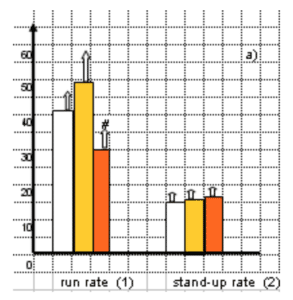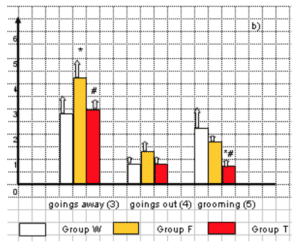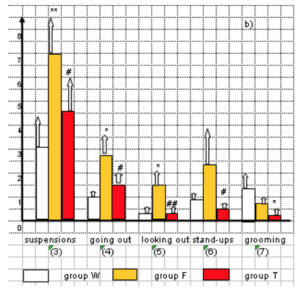Report re: results obtained in the studies of neurotropic effects, such as can be produced by three water samples tests (W, F and T)
During the studies, tests were performed upon a number of groups of male white rats (body mass: 220 g). Each group contained 10 animals. The rats were kept in standard-type cuvettes and, for 13 days, they had to drink water samples W, F and T provided for the purpose. For evaluation of effects produced by the water samples upon the animals’ behavior patterns, the following standard methods were used:
1. “Open Field” method
The open field was an arena of 80 cm in diameter, with a wooden floor, whereon eight diameters and two concentric circles equidistant from each other were drawn. The arena was surrounded with a wall of 40 cm in height. 80 cm above the arena surface, an electric lamp (power: 200 W), a household electric bell and a red lamp (power: 15 W) were placed. When tested, an animal was put into the arena center, and, for 2 minutes to follow, the following parameters were visually evaluated:
- Horizontal motive activity – the run rate (the number of sectors passed);
- Vertical motive activity – the stand-up rate (the number of standing positions taken in reliance upon the hind legs only);
- Goings away from the arena walls (the number of crossings made through the external concentric circle);
- Goings out into the arena center (the number of crossings made through the internal circle);
- Muzzle washings – grooming (the number of muzzle touches made by the forepaws).
Researches of medicinal products are usually based on a stressor-free modification of “Open Field” method.
2. “Uplifted Cruciform Labyrinth” method
Essentially, the test chamber used is a cruciform labyrinth (length of its arms: 35 cm; height of its walls: 20 cm). Two arms lying opposite of each other were shaded and shut-in with walls at their lateral sides; the other two were, on the contrary, lighted and left open. The labyrinth was installed on the height of 50 cm above the floor. A rat was put into the center of the labyrinth and, for 3 minutes to follow, the following parameters were read:
- Latent period of entrance into the shut-in arm (sec.);
- Total time of staying in the lighted area (sec.);
- Suspensions from the open labyrinth arms (the number of such suspended positions taken);
- Goings out into the open arms (the number of such goings out);
- Looking out of the shut-in labyrinth arms (the number of such looks out);
- Stand-ups in the lighted area (the number of such standing positions taken);
- Muzzle washings – grooming (the number of such washings).
Parameters 1, 2, 3, 4, 5 and 7 are descriptive of the level of anxious & phobic and emotional states the animals were in (if any). Parameters 3, 4 and 6 are sufficient for evaluation of the levels of orientation & research responses the animals displayed (if any).
3. “Vertical Net” method
Physical endurance of the animals was evaluated with use of “Vertical Net” method. Test equipment used for the purpose was a net made of wire and containing 1.5 x 1.5 mm cells, total area: 30 x 60 cm. On the top and on its lateral sides, the net was spatially confined by wooden walls. When tested, a rat was put onto the net, and records were made of period elapsing between the putting-on time and the time of falling off the net. The measuring was made 3 times successively, with maximal keeping-on-the-net time used for the analysis.
The experiments were performed by the blind method, and all information on water sample used in each case (whether Sample W, F or T) was obtained at the stage of preparation of this report. The obtained data were subjected to statistical processing within STATISTICA standard package of software. For purposes of comparisons between the averages and the distribution forms, Student’s criterion and Fischer’s precise criterion were used. Differences between the groups were treated as reliable, in case error probability was p<0.05. The charts show data stated as (average ± standard average error).
Results of the experiment
Basing on results obtained with use of “Open Field” method, conclusion can be made that water of Sample F (ZEPTER filter) acts to intensify the motive activity and the number of goings out made by the animals into the center of the arena; this an evidence pointing out at a pathological reduction in the sense of anxiety in the rats; such reductions entail loss of the sense of caution and a growth in the risk of getting into a critical situation (Illustration 1).
Water of Sample T (filter + generator) acts to normalize state the animals are in by way of bringing their behavior parameters back to the control levels (Illustration 1).


Illustration 1
*Reliable differences from Group W (p<0.05) and **(p<0.01), respectively
#Reliable differences from Group F (p<0.05) and ##(p<0.01), respectively
Uplifted Cruciform Labyrinth” test showed that it is a reliable fact that use of Water F increases time spans spent by the rats in lighted areas of the labyrinth, as well as the number of suspensions from the lighted labyrinth ends and the number of goings out into the center. The obtained data show a large reduction in the emotional anxiety in the rats and their loss of the sense of caution (Illustration 2).
Use of Water T acts to normalize, virtually fully, the state of the animals by way of bringing their behavior patterns to the levels of Control Group W (Illustration 2).


Illustration 2
| *Reliable differences from Group W (p<0.05) and **(p<0.01), respectively |
| #Reliable differences from Group F (p<0.05) and ##(p<0.01), respectively |
Use of water Samples F and T produced no effects upon the under-test animals’ physical endurance, which was evaluated within “Vertical Net” test.
Conclusion
The experimental data obtained provide reasons to conclude that water put through ZEPTER filter acquired properties of a neurotropic substance by acting to increase the orientation & research responses and to reduce the sense of anxiety in the rats. These effects should not be treated as beneficial, since each animal with a reduced sense of caution, if it lives in the natural environment, meets its end before long, inevitably.
Use of Group T water (ZEPTER + generator) does not entail the above-described ill effects, and the animals’ behavior patterns are retained at their initially optimal levels. Use of all water samples tested does not affect, in any way, the physical endurance of the white rats.
| Round seal: M.V. Lomonosov Moscow State University* Department of Biology* A state education & research institution* State Registration No. 95905* Moscow* Seals Register Entry No. 05700029070* | M.V. Lomonosov Moscow State University Department of Biology Chair of Human and Animal Physiology Head Officer, Doctor of Biology, Professor(Signed) /A.A. KAMENSKY/ |